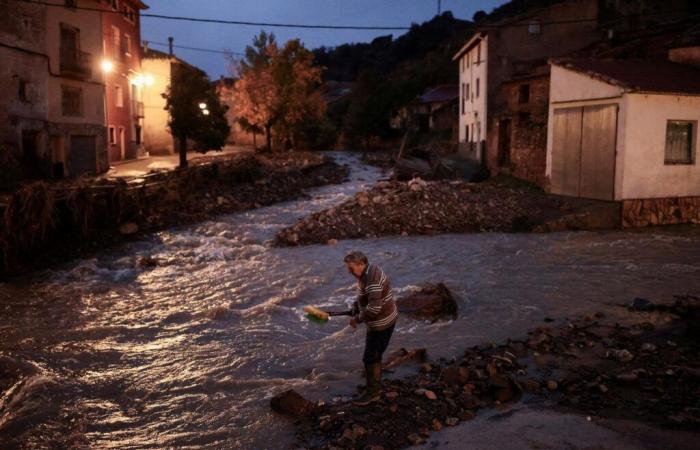The death toll from this week's apocalyptic floods in southeastern Spain reached 205 dead at midday Friday, November 1, as searches continued to find “dozens and dozens of missing”. Unheard of in Spain since deadly floods in October 1973. According to the Spanish meteorological agency (Aemet), certain localities experienced “the equivalent of a year of precipitation” in a few hours. The town of Chiva, west of Valencia, recorded 491 mm of rain per square meter, or 491 liters…
This deluge was caused by a phenomenon common at this time of year, called the “cold drop”. This isolated depression at altitude has been amplified by global warming, according to Jorge Olcina, professor of climatology at the University of Alicante. Cold drops may have effects “very similar” to those of a ” hurricane “insists this researcher.
“With global warming, the abnormal becomes normal”, alarms Clément Gaillard, doctor in urban planning. But climate change alone cannot explain the extent of the damage experienced by the region. The galloping urbanization of the Spanish coast, partly driven by mass tourism, probably contributed to the spectacular flooding of recent days.
Excessive artificialization
Between 1987 and 2005, the first 500 meters of the Spanish coastline were artificialized, at the rate of two hectares per day, the equivalent of two football fields. This is the assessment drawn up by a report by the NGO Greenpeace, published in 2018. An excessive artificialization which has not been thwarted by the public authorities. Spain does not have a climate change adaptation plan.
A little more than 23% of Valencia's literal area is concrete. According to Greenpeace, it is the second most artificial in Spain, in second position just behind Catalonia which exceeded 26%. A situation which makes a tourist area more vulnerable by nature subject to hazards according to Clément Gaillard: “A tourist area is by definition a vulnerable area: in the mountains, avalanches; by the sea, flooding and coastal retreat. »
The disappearance of the orchards
L’“uncontrolled urbanization poorly adapted to the natural characteristics of the territory” of recent years demonstrates a lack of political vision in terms of land artificialization, underlines Pablo Aznar, researcher at the Socio-economic Observatory of Floods and Drought (Obsis). Urban density is fundamental to explaining the impact of these floods. The metropolitan area of Valencia (south-east), where the vast majority of deaths took place, has 1.87 million inhabitants. It is the third largest city in Spain.
“The problem with Valencia is that it is an outlet city for a watershed, where the waters will converge. This is why a canal was created in 1950, to limit water flows, by passing them from the north to the less urbanized south of the city, explains Clément Gaillard. Added to this is the disappearance of orchards, which constituted a buffer zone, which has increased the vulnerability of the territory over the years.”
Between 1956 and 2011, 9,000 hectares of these orchards were removed, almost the size of Paris intra muros (10,540 ha). “To the west of Valencia, you have a huge commercial area, the water does not infiltrate, as if it were a huge plastic sheet. Ideally, the water should infiltrate and this involves the construction of retention basins”he continues.
According to a quick calculation by the town planner, the artificialization of this surface – and therefore of its capacity to absorb rainwater – would have contributed to the runoff of approximately 13,500,000 cubic meters of additional water. “This represents the equivalent of 5,400 Olympic swimming pools, which also spilled into the streets and houses and worsened this flood and its consequences,” he emphasizes.
Reinventing urban planning
Faced with these challenges, legislation must be developed “which plans the urbanization of the coastline. This was the case at La Grande Motte, built at the end of the 1960s to offer an alternative to holidays in Spain for the French. 30% of urbanized areas and 70% of natural areas have been planned. explains Clément Gaillard.
However, in 1956, a categorization of soils had been introduced in Spain, but it was only in 2007 that the State divided them into two statuses: rural area and urban area. In 2013, a law focused on protecting areas at risk of erosion. But Spanish legislation does not have a legal equivalent to the concept of “land artificialization”, underlines a report from the French Senate.
In reality, to combat these phenomena, it is necessary “develop a culture of risk, like in Japan with earthquakes. Train children to react and improve warning systems » estimates the urban planner, who emphasizes that in Mediterranean countries, periods of drought linked to extreme heatwaves are accompanied by periods of intense rain. “It’s curious that the government doesn’t think about water stress and flooding togetherhe concludes. They are, however, two sides of the same coin..






